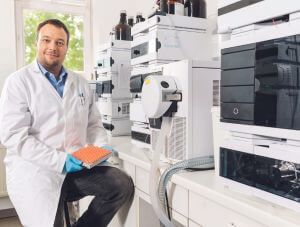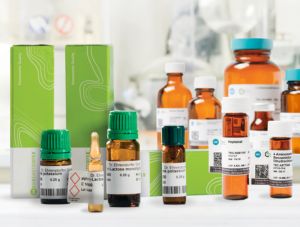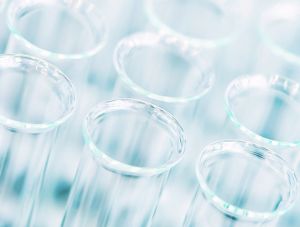
Polychlorinated biphenyls (PCBs), dioxins and furans are three loosely related families of toxic chemical compounds that are all categorised as Persistent Organic Pollutants (POPs) under the Stockholm Convention. In this article, we examine their history, toxicity, and ubiquity, as well as answering some fundamental questions, such as “What is a PCB?”, “What are PCBs’ environmental effects?”, “What are dioxins?”, and “How are dioxins formed?” We also investigate the potential dangers of furans, dioxins, and polychlorinated biphenyls in food, the slow progress on cleaning up the environment to date, and discuss how analytical testing might evolve to meet the threat of a new generation of PCBs.
What are PCBs?
The chemical definition of PCBs, also commonly called biphenyls, is: a group of more than 200 synthetic aromatic compounds, each containing between one and 10 chlorine atoms attached to a biphenyl nucleus. When combined in mixtures with other polychlorinated biphenyl compounds early in the last century, many of these PCBs acquired commercially valuable physical characteristics – such as insulating properties, non-flammability, and resistance to thermal and biological degradation. This made them useful in a wide range of industrial and consumer products made between the late 1920s and the early 1980s – from coolants, transformers and electrical components to paints, telephones and waffle irons. Before they began to be banned in the late 1970s, around 1-1.5 million tonnes of PCBs were produced worldwide - about 50% of them in the United States (US).
PCB toxic effects
As the US Environmental Protection Agency (US EPA) states on its polychlorinated biphenyls page, “PCBs have been demonstrated to cause a variety of adverse health effects” in both animals and humans – including damaging the immune systems of rhesus monkeys, seriously affecting the reproductive systems of monkeys and other animals, and causing endocrine disruption in rodents. Studies of how PCBs affect those same systems in humans have also reported similar findings. In addition, exposure to PCBs has been linked to adverse neurological effects such as neuroinflammation, glial activation, neurological impairments, and behavioural changes including anxiety and depression. Last but not least, PCBs have been classified as probably carcinogenic by several international agencies – including the US EPA and the International Agency for Research on Cancer (IARC).
PCB environmental impacts
The 20th century PCB manufacturing boom between means that today, according to the United Nations Environment Programme (UNEP), PCBs can be found “everywhere”. Vast amounts of PCB-containing materials remain in landfills and hazardous waste sites around the globe, with an estimated 200,000 tonnes of PCB waste landfilled in Europe alone. Many of these discarded items leach PCBs into the wider environment, particularly in landfills that are close to water or prone to flooding. In 2022, a study from China reported “Serious PCB contamination... in e-waste disassembling areas” in Zhejiang Province and Guangdong.
Once they have escaped from refuse sites and into waterways, many PCB residues settle in soils and sediments of lakes, estuaries and rivers nearby. However, others are “released into the air, resulting in long-range atmospheric pollution as PCBs are easily transported by wind and air currents.” PCBs not only travel vast distances by constantly cycling between air, water, snow and soil, but also persist for long periods – presenting what UNEP calls “a toxic legacy to the environment and to human health.”
Polychlorinated biphenyls in food
One main reason for this toxic legacy is the tendency for PCBs to biomagnify. This means that a PCB chemical will initially accumulate in the fatty tissues of small animals like fish, and then in greater concentrations in a larger animal that eats that fish, and so on up the food chain. Therefore, marine mammals and fish-eating birds have higher concentrations of PCBs in their fatty tissues than their prey. This can have deadly consequences for so-called “top predators”, as was shown by a recent study linking PCBs to an increased risk of mortality in dolphins. After studying more than 800 dolphins stranded in the UK between 1990 and 2020, British and Irish researchers discovered that a rise of one milligram of PCBs per kilogram of blubber equated to a 1.6% higher likelihood of conditions like pneumonia, enteritis, and bacterial infection becoming fatal. Given that every person in the world probably has traces of a PCB chemical in their body - and that foods like fish, meat and dairy account for 90% of our exposure to PCBs - humans are also considered particularly vulnerable to the PCB biomagnification process. For example, Portuguese researchers last year concluded that the lifetime carcinogenic risk to individuals consuming mussels caught off the North Atlantic coast was “factual”, given the significant amounts of PCBs they detected in bivalves, water and particulate matter.
The risks from dioxins and furans: key facts
The term “dioxins” describes two structurally and chemically similar groups - polychlorinated dibenzo para dioxins (PCDDs) and polychlorinated dibenzofurans (PCDFs) - while some PCBs with similar toxic properties are also considered dioxins. Of the 419 dioxin-related compounds identified so far, about 30 are considered significantly toxic, with 2,3,7,8- tetrachlorodibenzo para dioxin (TCDD) the most dangerous.
Most dioxins are not produced intentionally, but created when other chemicals or industrial products are made: for example, during smelting, and bleaching paper pulp with chlorine. Dioxins can also result from natural processes, such as volcanic eruptions and forest fires.
Dioxins are found throughout the environment and accumulate in the food chain, mainly in animal fatty tissue. As with PCBs, the higher an animal is in the food chain, the higher the concentration of dioxins.
More than 90% of human exposure to dioxins is through food: mainly meat and dairy products, fish and shellfish.
Exposure to dioxins can cause reproductive and developmental problems in humans, damage the immune system, and interfere with hormones. The US EPA has also said that TCDD is likely to cause cancer in humans.
As well as taking action to reduce emissions of dioxins and furans into the environment, businesses and governments need to take effective action to avoid secondary contamination of the food supply – by far the main source of human exposure to potentially toxic dioxins and furans. Food and feed contamination monitoring systems must be in place to ensure that tolerance levels are not exceeded, backed by high-quality, reliable reference materials for furans and dioxins testing.
Slow progress on cleaning up PCB pollution
Governments began taking action against PCB pollution in 1979, when the US banned PCBs, and the United Kingdom (UK) followed suit in 1981. Today, the world’s main weapon in cleaning up PCBs from the environment is the Stockholm Convention, which from 2004 banned PCB manufacturing, as well as new uses of the chemicals. The treaty also mandates its 152 signatories and 186 parties to eliminate the use of PCBs in equipment by 2025 and make “determined efforts” towards environmentally sound management of PCB toxic waste and contaminated equipment by 2028. This means that PCB-using industries and governments must identify, label and remove PCBs from electronics, while liquid PCBs and other items containing polychlorinated biphenyls should be destroyed by high temperature incineration. Already, however, the world is far behind schedule on cleaning up PCBs. In January 2016 UNEP estimated that only three million tonnes of equipment and materials containing PCBs had been eliminated, with 14 million tonnes - or 83% of the total - still to be dealt with.
Will UP-PCBs mean more polychlorinated biphenyl testing?
While the world struggles to clean up legacy PCBs, a new problem is emerging: Unintentionally Produced PCBs (aka UP-PCBs). Over the past decade, scientists have detected increasing levels of “contemporary” PCB congeners that are formed inadvertently during industrial thermal processes - including waste incineration and metallurgy, as well as cement and pigment production. These UP-PCPs now make up a significant and increasing proportion of all PCB emissions, and the Manchester Metropolitan University researcher David Megson has even speculated that - because of UP-PCBs and despite the Stockholm Convention - more polychlorinated biphenyls could be being released into the environment today than during the peak production years of the 1970s. Whilst this might overestimate UP-PCB emissions, many agree with Megson’s argument that polychlorinated biphenyl testing needs to adapt and expand in order to identify the true scale of the UP-PCB issue. Writing in The Conversation last September, Lancaster University’s Andrew Sweetman stated that, while routine testing of just a few PCBs has in the past “been a good indicator of the presence of commercial mixtures... future monitoring programmes need to test for more types of PCBs to take the presence of unintentionally produced PCBs into account.”
LGC Standards – high quality reference materials for your evolving testing needs
To protect and preserve the world from the adverse effects of PCBs, dioxins, and furans, and to meet global regulatory obligations, analytical laboratories and research scientists need to test for these ubiquitous pollutants regularly. High-quality reference materials and research chemicals can play a critical role in helping you to deliver reliable results, as well as staying up-to-date with regulatory and scientific change.
Our extensive portfolio of products for analysing PCBs in food and the environment features neats, single solutions and mixtures that cover all 209 PCB congeners – in both native and labelled formats. It also includes more than 400 Dr Ehrenstorfer reference materials certified to either ISO 17034 or 17025, plus ready-made mixtures enabling you to address national and international PCB regulations – including US EPA methods, EU guidelines, and Chinese GB and HJ standards.
Constantly innovating to anticipate future market needs and address regulations, we now offer a new range of ISO 17134-accredited, 13C labelled reference materials - designed for studying the toxic effects of PCBs on living organisms, but also ideal as internal standards in routine testing.
|



